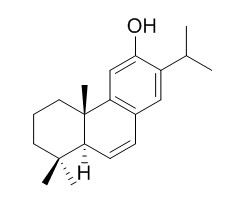6,7-Dehydroferruginol
6,7-Dehydroferruginol has potent activity against F. palustris . 6,7-Dehydroferruginol and sugiol are weakly active against Heterosigma akashiwo.
Inquire / Order:
manager@chemfaces.com
Technical Inquiries:
service@chemfaces.com
Tel:
+86-27-84237783
Fax:
+86-27-84254680
Address:
1 Building, No. 83, CheCheng Rd., Wuhan Economic and Technological Development Zone, Wuhan, Hubei 430056, PRC
Providing storage is as stated on the product vial and the vial is kept tightly sealed, the product can be stored for up to
24 months(2-8C).
Wherever possible, you should prepare and use solutions on the same day. However, if you need to make up stock solutions in advance, we recommend that you store the solution as aliquots in tightly sealed vials at -20C. Generally, these will be useable for up to two weeks. Before use, and prior to opening the vial we recommend that you allow your product to equilibrate to room temperature for at least 1 hour.
Need more advice on solubility, usage and handling? Please email to: service@chemfaces.com
The packaging of the product may have turned upside down during transportation, resulting in the natural compounds adhering to the neck or cap of the vial. take the vial out of its packaging and gently shake to let the compounds fall to the bottom of the vial. for liquid products, centrifuge at 200-500 RPM to gather the liquid at the bottom of the vial. try to avoid loss or contamination during handling.
Trop J Nat Prod Res, February2023, 7(2):2371-2381
Phytomedicine2022, 104:154337.
Nat Prod Sci.2016, 22(2)
Drug Des Devel Ther.2020, 14:5189-5204.
Nutr Res Pract2019, 13:e45
Korean J. Food Preserv.2023, 30(4):663-668.
J Agric Food Chem.2015, 63(44):9869-78
Asian J Beauty Cosmetol2021, 19(1): 57-64.
Biosci Rep.2018, 38(4)
Front Immunol.2024, 15:1423776.
Related and Featured Products
J Chem Ecol. 2010 Dec;36(12):1381-6.
Antifungal abietane-type diterpenes from the cones of Taxodium distichum Rich.[Pubmed:
21072573]
The chemical composition of Taxodium distichum cones and the antifungal activities of twelve diterpenoids against two wood decay fungi, Trametes versicolor (white-rot) and Fomitopsis palustris (brown-rot) were examined.
METHODS AND RESULTS:
The chemical composition of the major extractive fraction, the n-C(6)H(14) extract, was evaluated and its antifungal properties were identified. Twelve diterpenoids including ten abietane-type components were isolated from the n-C(6)H(14) extract: 6,7-Dehydroferruginol (1), ferruginol (2), 6,7-dehydroroyleanone (3), sandaracopimaric acid (4), taxodione (5), taxodal (6), taxodone (7), sugiol (8), xanthoperol (9), salvinolone (10), 5,6-dehydrosugiol (11), and 14-deoxycoleon U (12). Compounds 5 and 12 were highly active against both wood-decay fungi. In particular, the activities of these compounds against F. palustris were potent.
CONCLUSIONS:
The results suggest that the position and the number of hydroxyl groups on abietane-type structures may be related to antifungal activities against T. versicolor and F. palustris.
Journal of Wood Science, 2013 , 59 (3) :238-242.
Growth inhibition activities of Sugi bark components against Heterosigma akashiwo[Reference:
WebLink]
In our ongoing efforts to develop new uses for wood-based waste streams, the growth inhibition activities of extracts obtained from Sugi (Cryptomeria japonica) bark were examined against Heterosigma akashiwo, otherwise known as red tide plankton.
METHODS AND RESULTS:
The Sugi bark was separated into its outer and inner barks and then extracted sequentially with hexane, ethyl acetate, and methanol. Strong inhibitory activities against H. akashiwo were observed in the tests involving the hexane extract from the inner and outer barks, as well as the ethyl acetate extract from the inner bark. Gas chromatography mass spectroscopy (GC–MS) analysis revealed that cubebol, phyllocladanol, 6,7-Dehydroferruginol, ferruginol, and sugiol were the main components in the active extracts. These components themselves were then tested for their growth inhibition activities against H. akashiwo. Cubebol and ferruginol showed potent inhibitory activities, whereas phyllocladanol, 6,7-Dehydroferruginol, and sugiol were only weakly active.
CONCLUSIONS:
Taken together, these results suggested that the Sugi bark extracts could be used as inhibition reagents against red tide plankton.



